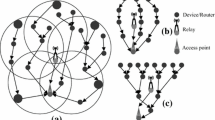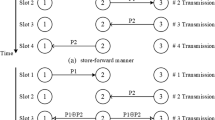Abstract
The converge-cast in wireless sensor networks (WSNs) is widely applied in many fields such as medical applications and the environmental monitoring. WSNs expect not only providing routing with high throughput but also achieving efficient energy saving. Network coding is one of the most promising techniques to reduce the energy consumption. By maximizing the encoding number, the message capacity per package can be extended to the most efficient condition. Thus, many researchers have focused their work on this field. Nevertheless, the packages sent by the outer nodes need to be temporary stored and delayed in order to maximize the encoding number. To find out the balance between inserting the delay time and maximizing the encoding number, a Converge-cast Scheme based on data collection rate prediction (CSRP) is proposed in this paper. To avoid producing the outdated information, a prediction method based on Modifying Index Curve Model is presented to deal with the dynamic data collection rate of every sensor in WSNs. Furthermore, a novel coding conditions based on CDS is proposed to increase the coding opportunity and to solve the collision problems. The corresponding analysis and experimental results indicate that the feasibility and efficiency of the CSRP is better than normal conditions without the prediction.

















Similar content being viewed by others
References
Ahlswede, R., Cai, N., Li, S., & Yeung, R. (2000). Network information flow. IEEE Transactions on Information Theory, 46(4), 1204–1216.
Chen, J., He, K., Du, R., Zheng, M., Xing, Y., & Yuan, Q. (2015). Dominating set and network coding-based routing in wireless mesh networks. IEEE Transactions on Parallel and Distributed Systems, 26(2), 423–433.
Chen, J., Li, T., & Du, R. (2011). Efficient reliable opportunistic network coding based on hybrid flow in wireless network. China Communications, 8(4), 125–131.
Ostovari, P., Wu, J., & Khreishah, A. (2014). Network coding techniques for wireless and sensor networks, the art of wireless sensor networks. Berlin: Springer.
Ye, X., Li, J., & Xu, L. (2014). Distributed separate coding for continuous data collection in wireless sensor networks. ACM Transactions on Sensor Networks (TOSN), 11(1), 17.
Le, J., Lui, J. C., & Chiu, D. M. (2008). How many packets can we encode?—An analysis of practical wireless network coding. In Proceedings of IEEE INFOCOM.
Jiang, H. B., Jin, S. D., & Wang, C. G. (2011). Prediction or not? An energy-efficient framework for clustering-based data collection in wirelesssensor networks. IEEE Transactions on Parallel and Distributed Systems, 22(6), 1064–1071.
Liang, Q., Zhang, J., & Zhang, Y. H. (2014). The placement method of resources and applications based on request prediction in cloud data center. Information Sciences, 279, 735–745.
Alippi, C., Camplani, R., Galperti, C., Marullo, A., & Roveri, M. (2013). A high-frequency sampling monitoring system for environmental and structural applications. ACM Transactions on Sensor Networks (TOSN), 9(4), 41.
Tang, Z. Z., Wang, H. Y., & Hu, Q. (2013). Network coding in convergecast of wireless sensor networks: friend or foe? In Proceedings of IEEE 24th international symposium on personal, pp. 2469–2473.
Tang, Z. Z., Wang, H. Y., Hu, Q., & Hai, L. (2012). How network coding benefits converge-case in wireless sensor networks. In Proceedings of IEEE vehicular technology conference (VTC Fall), pp. 1–5.
Ding, L., Wu, W., Willson, J., Du, H., Lee, W., & Du, D. Z. (2011). Efficient algorithms for topology control problem with routing cost constraints in wireless networks. IEEE Transactions on Parallel and Distributed Systems, 22(10), 1601–1609.
Hsu, C-H, Slagter, K. D., Chen, S. C., & Chung, Y. C. (2014). Optimizing energy consumption with task consolidation in clouds. Information Sciences, 258(10), 452–462.
Zhao, Y., Wu, J., Li, F., & Lu, S. (2012). On maximizing the lifetime of wireless sensor networks using virtual backbone scheduling. IEEE Transactions on Parallel and Distributed Systems, 23(8), 1528–1535.
Kui, X., Sheng, Y., Du, H., & Liang, J. (2013). Constructing a CDS-based network backbone for data collection in wireless sensor networks. International Journal of Distributed Sensor Networks, 9(2013), 233–256.
Li, S. Y. R., Yeung, R. W., & Cai, N. (2003). Linear network coding. IEEE Transactions on Information Theory, 49(2), 371–381.
Ho, T., Medard, M., Koetter, R., Karger, D., Effros, M., Shi, J., et al. (2006). A random linear network coding approach to multicast. IEEE Transactions on Information Theory, 52(10), 4413–4430.
Hou, I. H., Tsai, Y. E., Abdelzaher, T. F., & Gupta, I. (2008). Adapcode: Adaptive network coding for code updates in wireless sensor networks. In Proceedings of IEEE INFOCOM.
Katti, S., Rahul, H., Hu, W., Katabi, D., Mdard, M., & Crowcroft, J. (2006). XORs in the air: Practical wireless network coding. ACM SIGCOMM Computer Communication Review, 36(4), 243–254.
Le, J., Lui, J. C., & Chiu, D. M. (2010). DCAR: Distributed coding-aware routing in wireless networks. IEEE Transactions on Mobile Computing, 9(4), 596–608.
Guo, B., Li, H., Zhou, C., & Cheng, Y. (2011). Analysis of general network coding conditions and design of a free-ride-oriented routing metric. IEEE Transactions on Vehicular Technology, 60(4), 1714–1727.
Miao, L. S., Karim, D., Anish, K., & Noel, G. (2012). Network coding and competitive approach for gradient based routing in wireless sensor networks. Ad Hoc Networks, 10(6), 990–1008.
Lu, Z., Wu, L., Pardalos, P. M., Maslov, E., Lee, W., & Du, D. Z. (2014). Routing-efficient CDS construction in disk-containment graphs. Optimization Letters, 8(2), 425–434.
Du, H., Wu, W., Ye, Q., Li, D., Lee, W., & Xu, X. (2013). CDS-based virtual backbone construction with guaranteed routing cost in wireless sensor networks. Optimization Letters, 24(4), 652–661.
Du, H., Ye, Q., Wu, W., Lee, W., Li, D., Wu, Q.W., & Du, D. Z. (2011). Constant approximation for virtual backbone construction with guaranteed routing cost in wireless sensor networks. In Proceedings of IEEE INFOCOM, pp. 1737–1744.
Aziz, A. A., Sekercioglu, Y. A., & Fitzpatrick, P. (2013). A survey on distributed topology control techniques for extending the lifetime of battery powered wireless sensor networks. Optimization Letters, 15(1), 121–144.
He, J., Ji, S. L., & Pan, Y. (2014). Greedy construction of load-balanced virtual backbones in wireless sensor networks. Optimization Letters, 14(7), 673–688.
Wang, S., Vasilakos, A., Jiang, H. B., Ma, X. Q. (2011). Energy efficient broadcasting using network coding aware protocol in wireless ad hoc network. In Proceedings of IEEE international conference on communications (ICC), pp. 1–5.
Wang, X., Fu, L., Tian, X., Bei, Y., Peng, Q., Gan, X., et al. (2012). Converge cast: On the capacity and delay tradeoffs. Optimization Letters, 11(6), 970–982.
Ostovari, P., Khreishah, A., & Wu, J. (2012). Deadline-aware Broadcasting in wireless networks with network coding. In Proceedings of IEEE global communications conference (GLOBECOM), pp. 4435–4440.
Vazintari, A., Vlachou, C., & Cottis, P. G. (2013). Network coding for overhead reduction in delay tolerant networks. Optimization Letters, 72(4), 2653–2671.
Zhang, J., & Xu, L. (2013). Research on topology control system for mesh networks. Optimization Letters, 34(1), 140–144.
Zhang, J., Xu, L., Zhou, S. M., Wu, W. (2013). Constructing connected dominating set based on crossed cube in WSN. In Proceedings of IEEE 5th intelligent networking and collaborative systems, pp. 443–447.
Wang, D. J., Lin, L. W., & Xu, L. (2011). A study of subdividing hexagon-clustered WSN for power saving: Analysis and simulation. Optimization Letters, 9(7), 1302–1311.
Chen, B. L. (2011). Optimization theory and algorithms. Beijing: Tsinghua University Press.
Kim, D., Wu, Y., Li, Y., Zou, F., & Du, D. Z. (2009). Constructing minimum connected dominating sets with bounded diameters in wireless networks. Optimization Letters, 20(2), 147–157.
Zhang, J., Xu, L., & Lin, H. (2014). A CDS-based network coding scheme in wireless sensor converge-cast networks. In Proceedings of IEEE 17th international conference on computational science and engineering, pp. 1599–1604.
Acknowledgments
The authors wish to thank National Natural Science Foundation of China (Grant Nos.: 61072080, 61572010). National Natural Science Foundation of China (Nos. 61072080, U1405255). The Education Department of Fujian Province science and technology project (JAT160328, JA14217, JA15329), the scientific research project in Fujian University of Technology (GY-Z160066) Fujian Normal University Innovative Research Team (No. IRTL1207), Fujian provincial key project of science and technology (2015H0009, 2014H0008, 2014J01218).
Author information
Authors and Affiliations
Corresponding author
Rights and permissions
About this article
Cite this article
Xu, L., Zhang, J., Xiang, Y. et al. Network Coding Based Converge-Cast Scheme in Wireless Sensor Networks. Wireless Pers Commun 96, 4947–4972 (2017). https://doi.org/10.1007/s11277-016-3725-7
Published:
Issue Date:
DOI: https://doi.org/10.1007/s11277-016-3725-7




